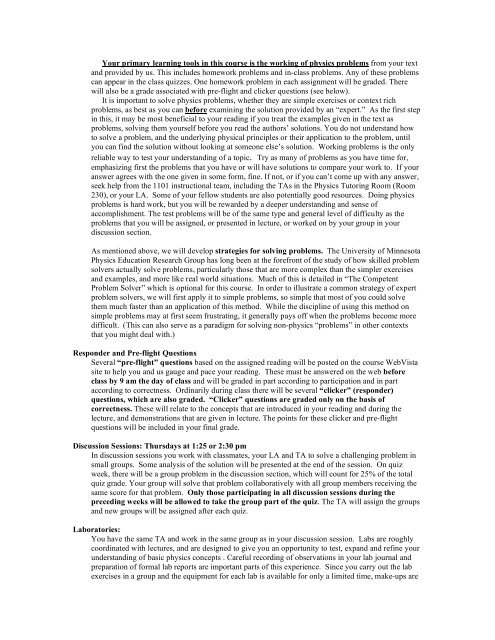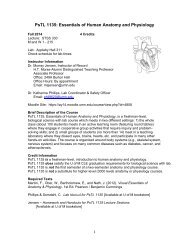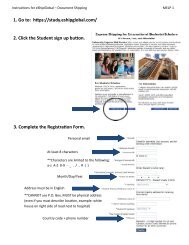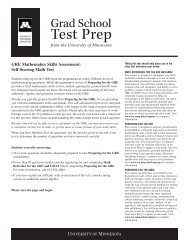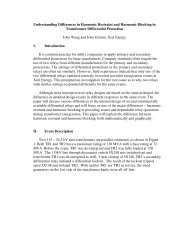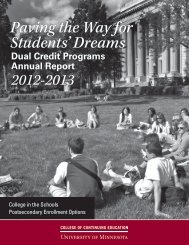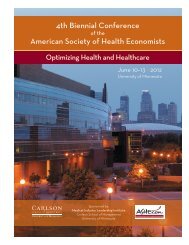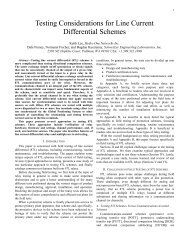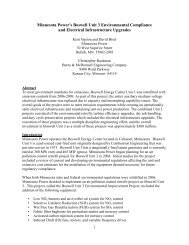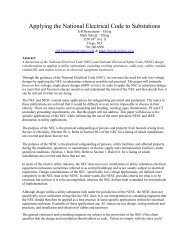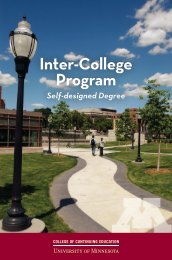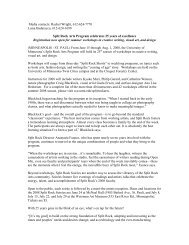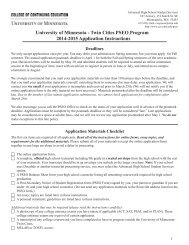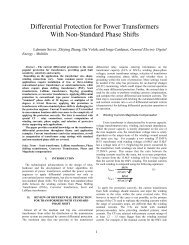Sample syllabus - College of Continuing Education - University of ...
Sample syllabus - College of Continuing Education - University of ...
Sample syllabus - College of Continuing Education - University of ...
You also want an ePaper? Increase the reach of your titles
YUMPU automatically turns print PDFs into web optimized ePapers that Google loves.
Your primary learning tools in this course is the working <strong>of</strong> physics problems from your text<br />
and provided by us. This includes homework problems and in-class problems. Any <strong>of</strong> these problems<br />
can appear in the class quizzes. One homework problem in each assignment will be graded. There<br />
will also be a grade associated with pre-flight and clicker questions (see below).<br />
It is important to solve physics problems, whether they are simple exercises or context rich<br />
problems, as best as you can before examining the solution provided by an “expert.” As the first step<br />
in this, it may be most beneficial to your reading if you treat the examples given in the text as<br />
problems, solving them yourself before you read the authors’ solutions. You do not understand how<br />
to solve a problem, and the underlying physical principles or their application to the problem, until<br />
you can find the solution without looking at someone else’s solution. Working problems is the only<br />
reliable way to test your understanding <strong>of</strong> a topic. Try as many <strong>of</strong> problems as you have time for,<br />
emphasizing first the problems that you have or will have solutions to compare your work to. If your<br />
answer agrees with the one given in some form, fine. If not, or if you can’t come up with any answer,<br />
seek help from the 1101 instructional team, including the TAs in the Physics Tutoring Room (Room<br />
230), or your LA. Some <strong>of</strong> your fellow students are also potentially good resources. Doing physics<br />
problems is hard work, but you will be rewarded by a deeper understanding and sense <strong>of</strong><br />
accomplishment. The test problems will be <strong>of</strong> the same type and general level <strong>of</strong> difficulty as the<br />
problems that you will be assigned, or presented in lecture, or worked on by your group in your<br />
discussion section.<br />
As mentioned above, we will develop strategies for solving problems. The <strong>University</strong> <strong>of</strong> Minnesota<br />
Physics <strong>Education</strong> Research Group has long been at the forefront <strong>of</strong> the study <strong>of</strong> how skilled problem<br />
solvers actually solve problems, particularly those that are more complex than the simpler exercises<br />
and examples, and more like real world situations. Much <strong>of</strong> this is detailed in “The Competent<br />
Problem Solver” which is optional for this course. In order to illustrate a common strategy <strong>of</strong> expert<br />
problem solvers, we will first apply it to simple problems, so simple that most <strong>of</strong> you could solve<br />
them much faster than an application <strong>of</strong> this method. While the discipline <strong>of</strong> using this method on<br />
simple problems may at first seem frustrating, it generally pays <strong>of</strong>f when the problems become more<br />
difficult. (This can also serve as a paradigm for solving non-physics “problems” in other contexts<br />
that you might deal with.)<br />
Responder and Pre-flight Questions<br />
Several “pre-flight” questions based on the assigned reading will be posted on the course WebVista<br />
site to help you and us gauge and pace your reading. These must be answered on the web before<br />
class by 9 am the day <strong>of</strong> class and will be graded in part according to participation and in part<br />
according to correctness. Ordinarily during class there will be several “clicker” (responder)<br />
questions, which are also graded. “Clicker” questions are graded only on the basis <strong>of</strong><br />
correctness. These will relate to the concepts that are introduced in your reading and during the<br />
lecture, and demonstrations that are given in lecture. The points for these clicker and pre-flight<br />
questions will be included in your final grade.<br />
Discussion Sessions: Thursdays at 1:25 or 2:30 pm<br />
In discussion sessions you work with classmates, your LA and TA to solve a challenging problem in<br />
small groups. Some analysis <strong>of</strong> the solution will be presented at the end <strong>of</strong> the session. On quiz<br />
week, there will be a group problem in the discussion section, which will count for 25% <strong>of</strong> the total<br />
quiz grade. Your group will solve that problem collaboratively with all group members receiving the<br />
same score for that problem. Only those participating in all discussion sessions during the<br />
preceding weeks will be allowed to take the group part <strong>of</strong> the quiz. The TA will assign the groups<br />
and new groups will be assigned after each quiz.<br />
Laboratories:<br />
You have the same TA and work in the same group as in your discussion session. Labs are roughly<br />
coordinated with lectures, and are designed to give you an opportunity to test, expand and refine your<br />
understanding <strong>of</strong> basic physics concepts . Careful recording <strong>of</strong> observations in your lab journal and<br />
preparation <strong>of</strong> formal lab reports are important parts <strong>of</strong> this experience. Since you carry out the lab<br />
exercises in a group and the equipment for each lab is available for only a limited time, make-ups are


